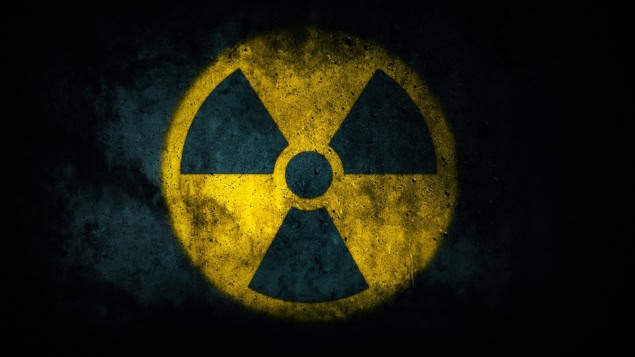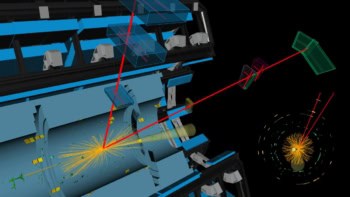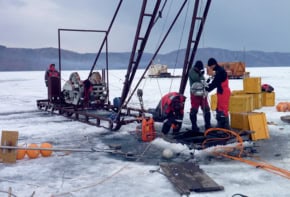
Researchers have demonstrated that they can remotely detect radioactive material from 10 m away using short-pulse CO2 lasers – a distance over ten times farther than achieved via previous methods.
Conventional radiation detectors, such as Geiger counters, detect particles that are emitted by the radioactive material, typically limiting their operational range to the material’s direct vicinity. The new method, developed by a research team headed up at the University of Maryland, instead leverages the ionization in the surrounding air, enabling detection from much greater distances.
The study may one day lead to remote sensing technologies that could be used in nuclear disaster response and nuclear security.
Using atmospheric ionization
Radioactive materials emit particles – such as alpha, beta or gamma particles – that can ionize air molecules, creating free electrons and negative ions. These charged particles are typically present at very low concentrations, making them difficult to detect.
Senior author Howard Milchberg and colleagues – also from Brookhaven National Laboratory, Los Alamos National Laboratory and Lawrence Livermore National Laboratory – demonstrated that CO2 lasers could accelerate these charged particles, causing them to collide with neutral gas molecules, in turn creating further ionization. These additional free charges would then undergo the same laser-induced accelerations and collisions, leading to a cascade of charged particles.
This effect, known as “electron avalanche breakdown”, can create microplasmas that scatter laser light. By measuring the profile of the backscattered light, researchers can detect the presence of radioactive material.
The team tested their technique using a 3.6-mCi polonium-210 alpha particle source at a standoff distance of 10 m, significantly longer than previous experiments that used different types of lasers and electromagnetic radiation sources.
“The results are highly impressive,” comments EunMi Choi from the Ulsan National Institute of Science and Technology in South Korea. Choi’s team had used a gyrotron source to detect radioactive materials back in 2017.
“The researchers successfully demonstrated 10-m standoff detection of radioactive material, significantly surpassing the previous range of approximately 1 m,” she says.
Milchberg and collaborators had previously used a mid-infrared laser in a similar experiment in 2019. Changing to a long-wavelength (9.2 μm) CO2 laser brought significant advantages, he says.
“You can’t use any laser to do this cascading breakdown process,” Milchberg explains. The CO2 laser’s wavelength was able to enhance the avalanche process, while being low energy enough to not create its own ionization sources. “CO2 is sort of the limit for long wavelengths on powerful lasers and it turns out CO2 lasers are very, very efficient as well,” he says. “So this is like a sweet spot.”
Imaging microplasmas
The team also used a CMOS camera to capture visible-light emissions from the microplasmas. Milchberg says that this fluorescence around radioactive sources resembled balls of plasma, indicating the localized regions where electron avalanche breakdowns had occurred.
By counting these “plasma balls” and calibrating them against the backscattered laser signal, the researchers could link fluorescence intensity to the density of ionization in the air, and use that to determine the type of radiation source.
The CMOS imagers, however, had to be placed close to the measured radiation source, reducing their applicability to remote sensing. “Although fluorescence imaging is not practical for field deployment due to the need for close-range cameras, it provides a valuable calibration tool,” Milchberg says.
Scaling to longer distances
The researchers believe their method can be extended to standoff distances exceeding 100 m. The primary limitation is the laser’s focusing geometry, which would affect the regions in which it could trigger an avalanche breakdown. A longer focal length would require a larger laser aperture but could enable kilometre-scale detection.
Choi points out, however, that deploying a CO2 laser may be difficult in real-world applications. “A CO₂ laser is a bulky system, making it challenging to deploy in a portable manner in the field,” she says, adding that mounting the laser for long-range detection may be a solution.

Tetris-inspired radiation detector uses machine learning
Milchberg says that the next steps will be to continue developing a technique that can differentiate between different types of radioactive sources completely remotely. Choi agrees, noting that accurately quantifying both the amount and type of radioactive material continues to be a significant hurdle to realising remote sensing technologies in the field.
“There’s also the question of environmental conditions,” says Milchberg, explaining that it is critical to ensure that detection techniques are robust against the noise introduced by aerosols or air turbulence.
The research is described in Physical Review Applied.



